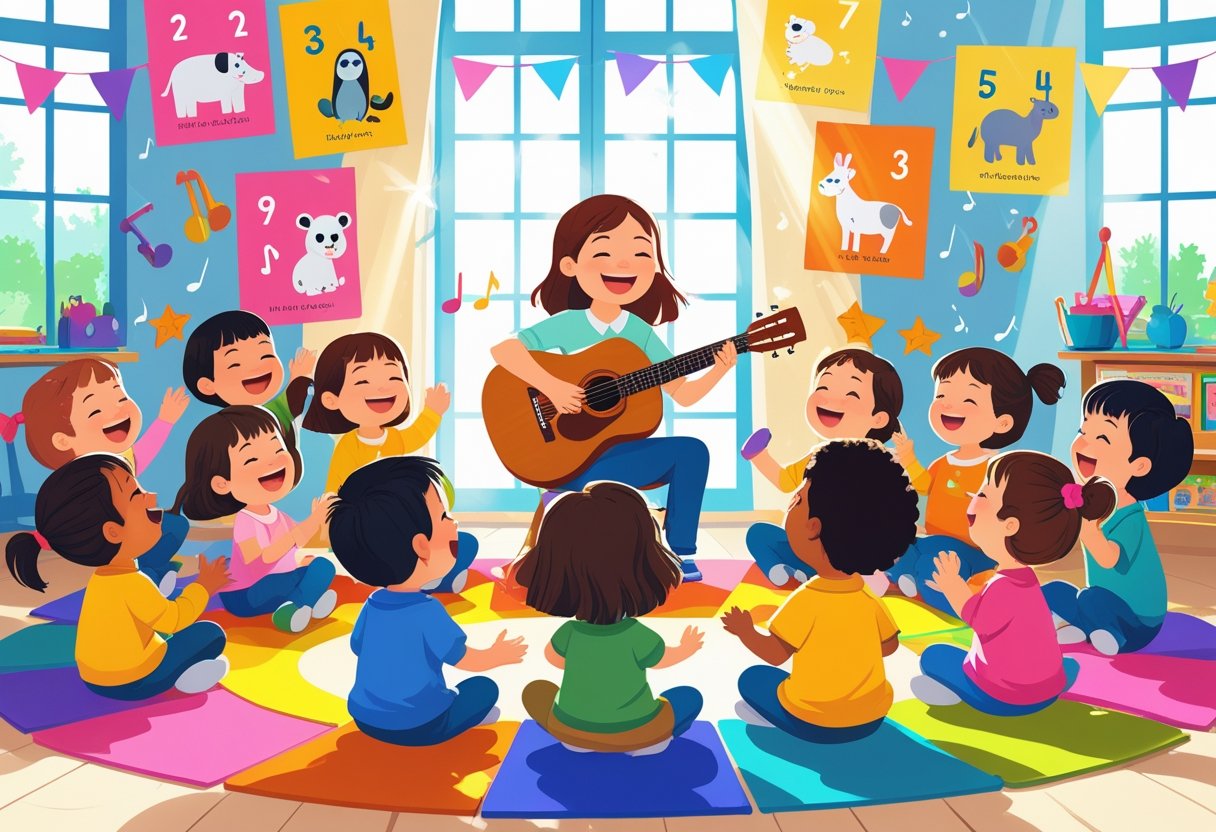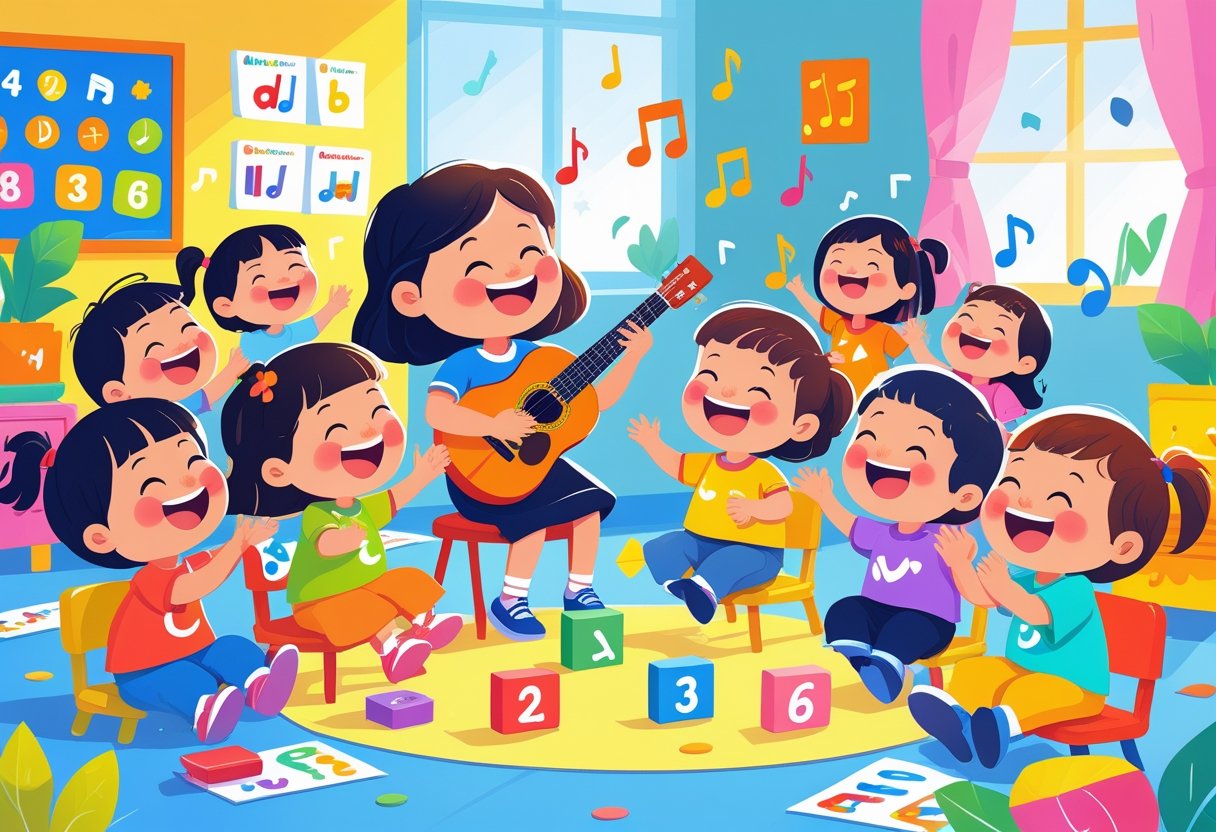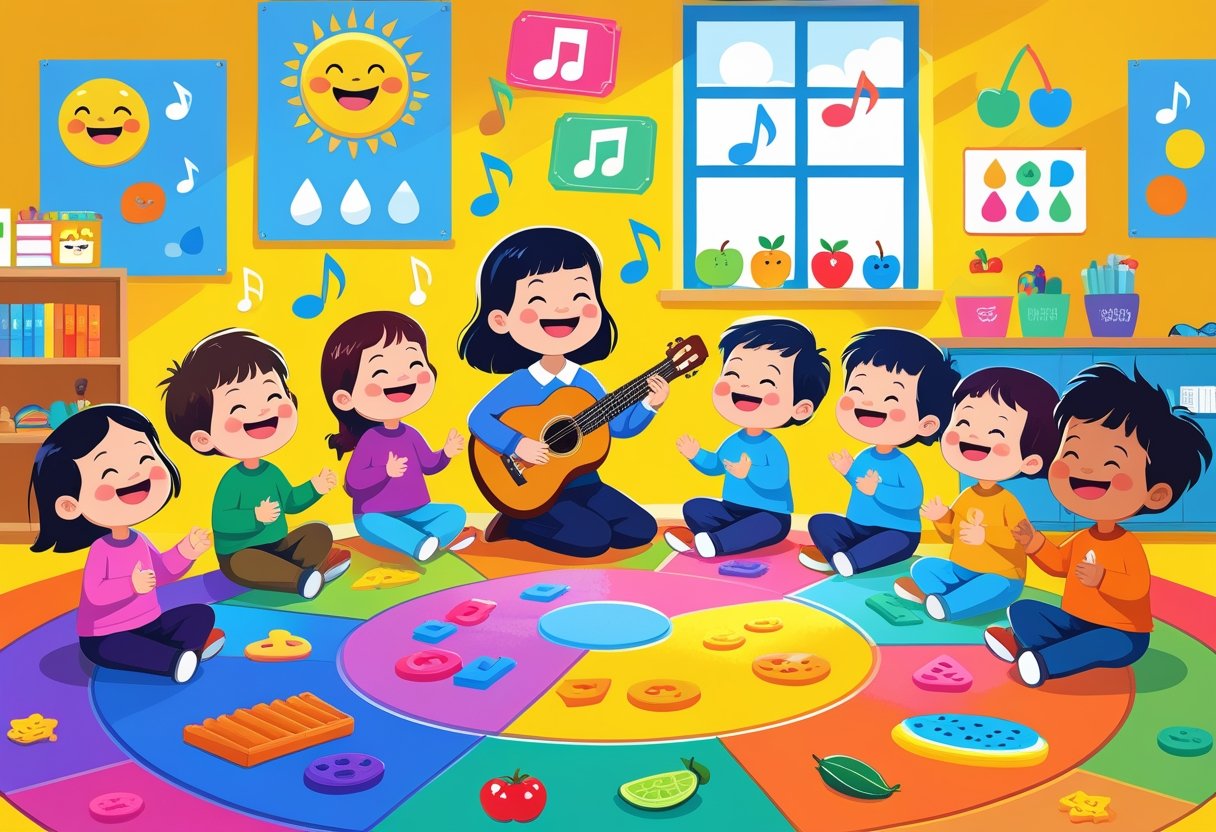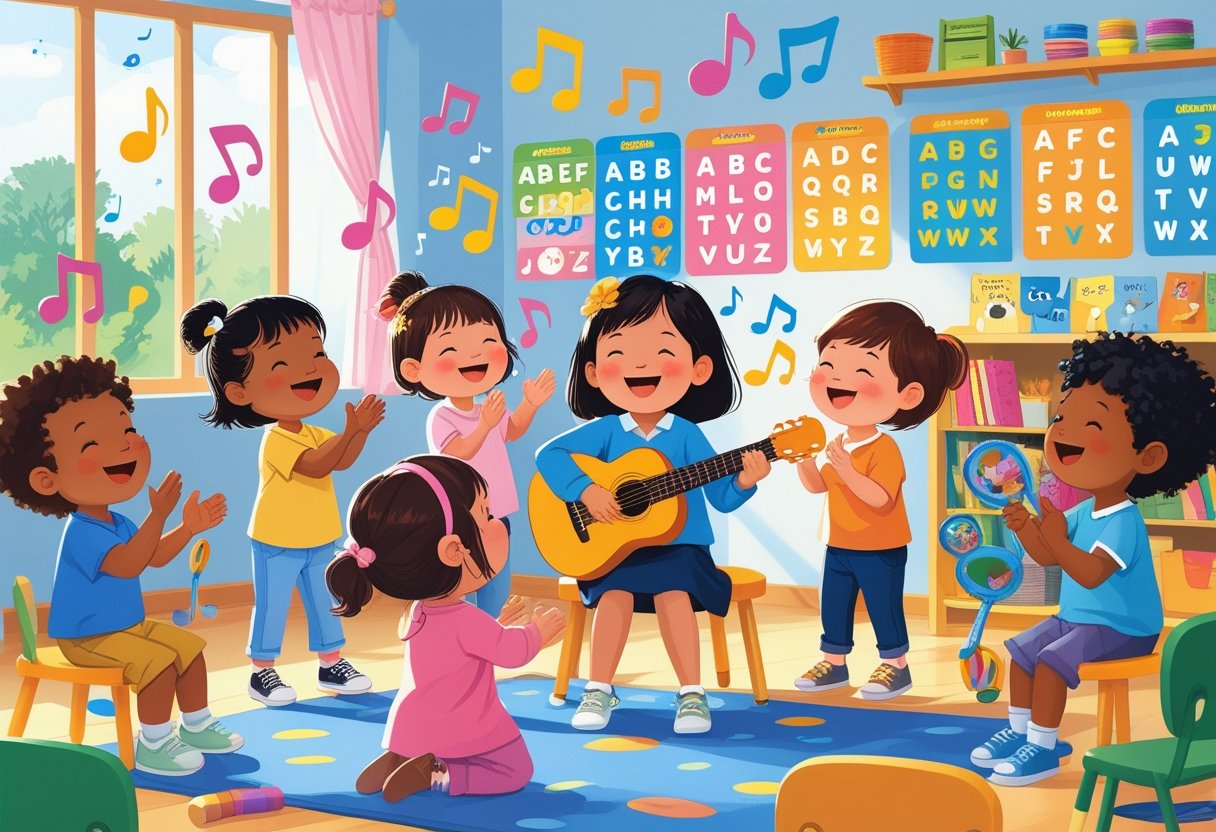Educational songs play a big role in helping preschoolers learn important skills like counting, recognising colours, and understanding letters.
These songs make learning easy and fun by combining simple words with catchy tunes, which helps young children remember new information better.

I’ve seen how songs that focus on basic concepts like shapes, numbers, and the alphabet support children’s language development and focus.
Using music in daily routines can truly boost a child’s ability to absorb and use new knowledge without feeling like they’re working hard.
Whether it’s classic nursery rhymes or specially made educational songs, the right music can keep preschoolers engaged and excited about learning.
I’ll share ideas and examples that can make learning at home or in the classroom more effective and enjoyable for little ones.
Benefits of Educational Songs for Preschoolers

Educational songs offer so many ways to help young learners grow.
They can improve important skills like talking, thinking, and handling emotions.
Songs also make learning fun and easier to remember for toddlers and preschoolers.
Supporting Language Development
Songs are a great way to boost language learning for preschoolers.
Repeating words and rhymes helps children hear sounds clearly and understand new vocabulary.
This practice builds a stronger foundation for speaking and reading later on.
For children with autism or learning disabilities, songs create a gentle way to practise speech in a calm, predictable setting.
The rhythm and melody help children focus and connect words with meaning.
I often notice that even shy toddlers join in when the tune is simple and catchy.
Using songs that feature clear, slow phrases supports pronunciation and listening skills.
These factors help children improve their communication with adults and peers.
Encouraging Cognitive Skills
Educational songs also strengthen thinking skills like memory, attention, and problem solving.
Preschoolers learn to follow patterns and order through repeated verses, which helps with early numeracy and sequencing.
Songs often ask children to count, name colours, or identify objects.
This type of learning turns abstract ideas into easy, fun exercises.
Songs that combine movement, such as clapping or jumping, build gross motor skills while stimulating the brain.
The mix of action and sound can particularly benefit young learners with learning disabilities by providing multiple ways to engage.
Fostering Social-Emotional Growth
Songs create chances for preschoolers to work together and express feelings safely.
Singing about emotions or everyday experiences helps children name their feelings and understand others.
When children sing in a group, they learn important social skills like waiting turns and cooperating.
This is valuable for all children, including those with autism who might find social settings challenging.
Songs often encourage positive behaviours, such as sharing or kindness.
These lessons use music to connect with children’s emotions deeply.
I find this makes songs a practical tool for emotional learning in early childhood.
Types of Educational Songs for Early Learners

Songs for young children are designed to help them learn in ways that hold their attention and build skills step by step.
These songs often focus on numbers, letters, colours, shapes, and familiar nursery rhymes that strengthen basic English vocabulary.
Counting and Number Songs
Counting songs like Five Little Ducks or simple 123s tunes are great for teaching numbers in order and the idea of counting up or down.
I often use these songs to help children memorise numbers and understand simple math ideas like addition and subtraction.
These songs include repetitive lines which make it easier for kids to join in and remember.
For example, Five Little Ducks is useful because it combines fun with learning how numbers decrease as ducks leave.
It also teaches basic vocabulary like “went out” and “came back.”
Counting songs are often paired with movements, such as holding up fingers, to make learning more active and engaging.
Alphabet and Phonics Tunes
Songs about the ABCs are excellent for introducing letters and their sounds.
I find that phonics songs help children link letters to their basic sounds, which is crucial for early reading skills.
These tunes, like the classic ABC Song, teach the alphabet in a familiar order.
Some songs go further and include words that start with each letter, helping to build basic English vocabulary.
Phonics tunes use short, clear sounds which make it easier for children to recognise how letters blend in words.
This also supports children when they start learning to read and write.
Nursery Rhymes and Classics
Traditional rhymes such as Old MacDonald Had a Farm, Baa Baa Black Sheep, and If You’re Happy and You Know It bring learning through familiar stories and actions.
I use these songs to teach rhythm, rhyme, and basic vocabulary.
These classics are useful because they include repeating phrases and clues to help children remember new words.
They also encourage group participation and physical movement, which helps with memory and coordination.
Nursery rhymes often cover common topics such as animals, feelings, and farm life, giving kids simple context to connect words with real-world ideas.
Songs for Teaching Colours and Shapes
Songs focused on colours and shapes help children identify and name what they see around them.
I like to use songs that teach colours through fun activities like a rainbow scavenger hunt to keep children active and interested.
Shape songs cover basic shapes such as circles, triangles, rectangles, and ovals.
These songs often show how shapes appear in everyday objects, making it easier for children to link abstract concepts to real life.
These songs improve vocabulary by naming colours like red, blue, and green, and shapes that form the building blocks for early math and art skills.
Most importantly, they are simple and interactive, which supports learning through play.
Effective Ways to Use Songs in Preschool Education

When using songs with young children, I focus on how to fit them naturally into learning and daily activities.
Songs help with language skills, turning routines into fun moments, and guiding kids through changes smoothly.
Here’s how I apply these ideas effectively.
Strategies for Teachers and Parents
I find that choosing the right songs makes a big difference.
For ESL teachers or parents working with young learners, songs should be simple and clear.
Repetition is key; kids learn better when they hear the same phrases often.
Using songs that teach numbers, colours, or animals helps children remember facts while they sing.
I also encourage mixing in music from different cultures.
This supports language learning and helps children appreciate diversity early on.
I recommend using playlists on platforms like Spotify to organise songs.
Having a set of go-to tracks saves time and keeps the energy positive in the classroom or home.
Integrating Songs into Daily Routines
I use songs to mark regular parts of the day, such as snack time, clean-up, or storytime.
Singing during these moments makes routines clear and fun.
It also helps children feel more secure because they know what’s coming next.
For language learning, I choose songs with short, repeated phrases that connect with activities.
For example, a song about washing hands before lunch can remind kids without needing constant verbal reminders.
Consistency matters here.
I play or sing the same songs during a routine until children respond to the cues naturally.
This builds independence and smooths transitions between tasks.
Transition Songs and Movement Activities
Changing from one activity to another can be tricky.
I use transition songs paired with simple movements to guide children calmly.
These songs act like signals—when kids hear them, they know to stop one thing and prepare for the next.
Movement songs work well to burn off energy while reinforcing learning.
I pick songs with actions that relate to the words, which supports comprehension, especially for English language learners.
Sometimes, I combine quiet songs with stretching or gentle dancing.
This balances excitement with calm, helping kids settle down or focus before moving on.
Using music this way turns transitions from stressful moments into fun, learning opportunities.
Popular Educational Song Platforms and Resources
I find it helpful to use a mix of video, audio, and online resources when teaching preschool children with songs.
These tools offer varied content that keeps young learners interested and makes it easier to find songs suited to different learning goals.
YouTube Channels for Preschool Learning
YouTube has many channels with educational songs for preschool children.
One of the most popular is Busy Beavers.
Their videos combine colourful animation and simple lyrics that help children learn numbers, letters, and social skills.
The visual and musical elements work together to hold a child’s attention.
Many channels on YouTube also include sing-along features and action songs, which encourage movement and help with memory.
I often use channels that offer short, repetitive songs because preschoolers respond well to repetition.
These channels usually update their content regularly, so there is always something new to explore.
Music Streaming Services for Children
Services like Spotify provide curated playlists specifically made for young children.
These playlists include clear, easy-to-understand songs that teach basic concepts such as the alphabet, counting, and good behaviour.
The sound quality is reliable, and you can often download songs for offline use, which is great for travel or places without internet.
Spotify’s kid-friendly playlists often feature popular educational artists and sometimes remix classic nursery rhymes to keep them fresh.
I value how easy it is to find content grouped by themes or learning goals, which simplifies planning a learning session with music.
Educational Song Collections and Playlists
There are many websites and apps offering song collections for preschool learners.
These resources often provide backing tracks, lyric sheets, and even scores, which can help teachers and parents engage children in music-making.
For example, platforms like Charanga offer organised collections that make it simple to choose songs for different topics and skills.
These collections focus on interactive learning, helping children develop language and coordination while enjoying music.
Using these resources, I can tailor the music experience to what children need most at the time.
Frequently Asked Questions
I’ve gathered key information about songs that help preschool children learn.
This covers popular songs, where to find lyrics, free resources, songs with actions, suitable music types, and good YouTube channels.
These details should give clear guidance for anyone interested in educational songs for young kids.
What are the most popular educational songs for children in preschool?
Songs like “Row, Row, Row Your Boat” and “Five Little Ducks” are very popular.
These songs often teach counting, language, and simple concepts.
They are easy to sing and help children remember new words.
Where can one find lyrics to educational songs suitable for preschoolers?
You can find lyrics on websites dedicated to children’s music or educational platforms.
Some YouTube videos also include lyrics on the screen.
Many free sites list classic nursery rhymes and learning songs.
Can you recommend some free resources for educational songs aimed at preschool children?
Websites like the British Council’s LearnEnglish Kids offer free songs for young learners.
YouTube channels often post videos for free with educational songs.
Some apps and music stores provide sample songs without cost too.
What are some educational songs for preschoolers that include actions?
Songs such as “If You’re Happy and You Know It” and “Head, Shoulders, Knees and Toes” have actions.
These encourage physical movement while learning words.
They help develop coordination and keep children engaged.
What type of music is developmentally appropriate for 4-year-old children?
Simple, repetitive melodies with clear words work best.
Music with a steady rhythm and easy tunes helps children follow along.
Songs that teach basics like numbers, letters, or body parts are suitable.
Which YouTube channels offer the best learning songs for young children?
Harry Kindergarten Music is a solid choice—lots of catchy tunes that sneak in lessons. The videos are bright, voices are easy to understand, and honestly, kids seem to love them.
LearnEnglish Kids by the British Council is another one worth checking out. Their songs are playful but still manage to teach, and parents usually feel good about letting their kids watch.
Both channels feel pretty safe and are favorites among teachers too.